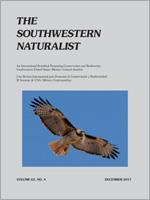We used spool-and-line tracking and habitat suitability modeling to delineate mobility and the environmental factors that influence the seasonal distribution and abundance of Lacey's white-ankled mouse (Peromyscus laceianus). Using trapping data from a 21-month period (February 2013–October 2014) in Val Verde County, Texas, we used MaxEnt modeling and a jackknife test of variable importance to determine that vegetation series and slope were the highest contributing variables in isolation. Using generalized linear modeling we found positive correlations with higher abundance indices in winter, spring, and fall among a variety of season-specific vegetation series. Using spool-and-line tracking, we determined P. laceianus to be highly mobile, indicating that this species is capable of dispersing to seasonally suitable habitats. Additionally, we observed higher degrees of arboreality in this region than reported from similar studies. Data suggest that vegetative habitat selection of this species varies seasonally and is likely dependent on the degree of seasonal resource availability within each vegetation type and the trophic ecology of P. laceianus.
How to translate text using browser tools
1 December 2017
HABITAT SUITABILITY MODELING AND SEASONAL MOVEMENTS OF Peromyscus laceianus (Lacey's white-ankled mouse) in Val Verde County, Texas
Clint N. Morgan,
Robert C. Dowler
ACCESS THE FULL ARTICLE

The Southwestern Naturalist
Vol. 62 • No. 4
December 2017
Vol. 62 • No. 4
December 2017




